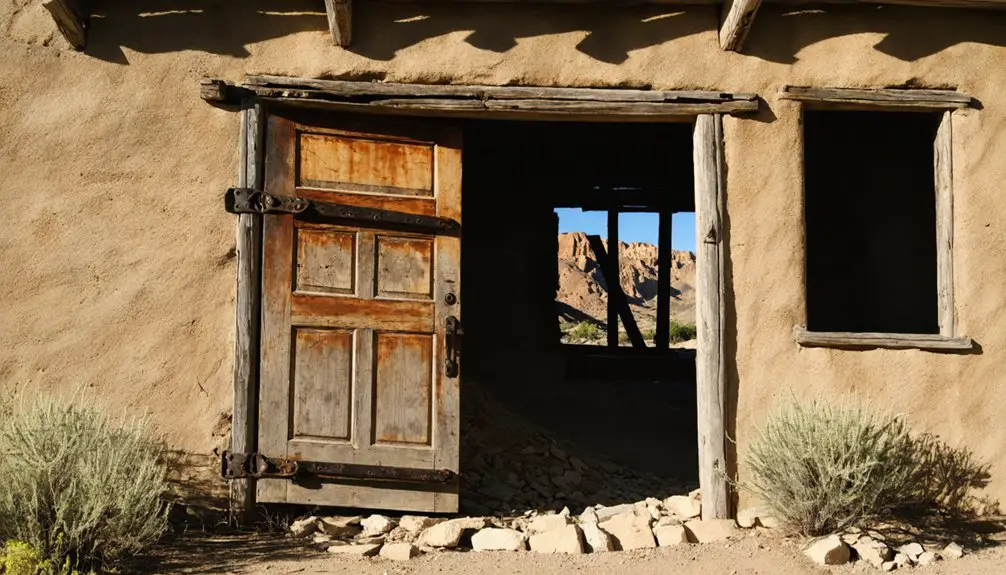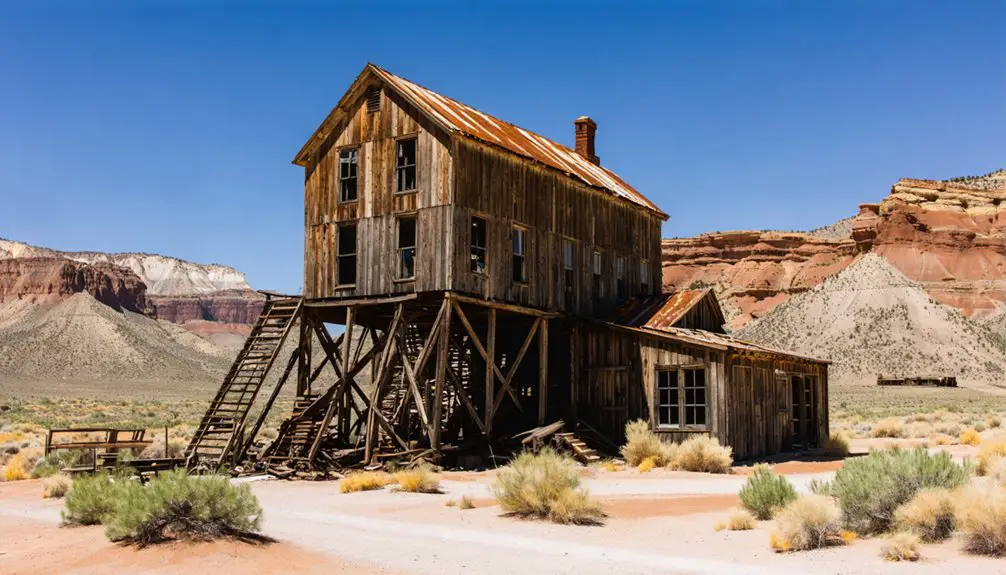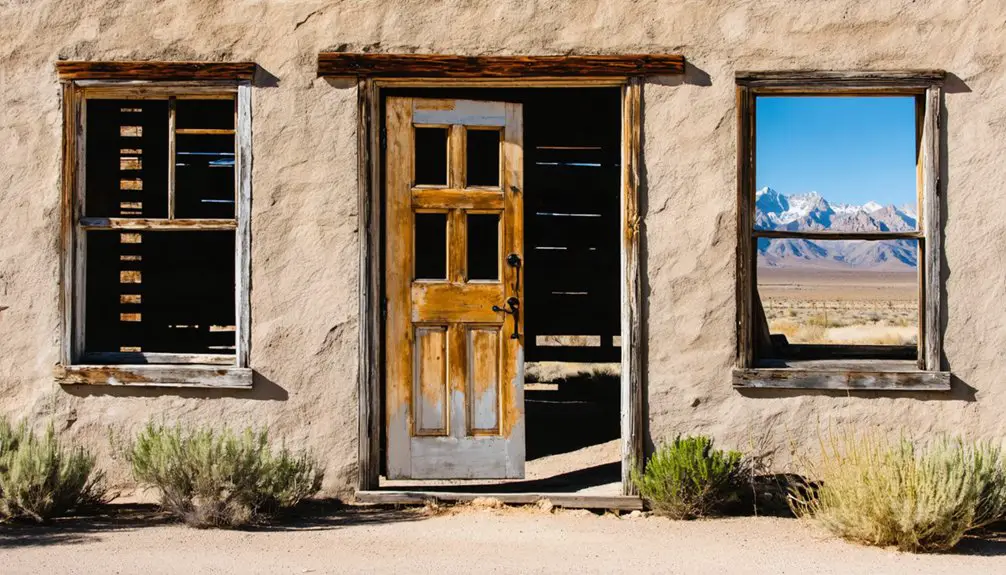You’ll find Lark’s story in Utah’s Oquirrh Mountains, where gold and silver discoveries sparked its founding in 1866 by prospectors Lark and Dalton. The town flourished under United States Smelting and Refining Company’s control, with the Mascotte Tunnel revolutionizing ore transportation. Kennecott Copper Corporation’s 1977 evacuation order forced about 50 families to relocate, transforming this once-vibrant mining community into a ghost town. The landscape still holds silent remnants of its industrial past.
Key Takeaways
- Lark was a mining town founded in 1866 in Utah’s Oquirrh Mountains, driven by gold and silver discoveries in Bingham Canyon.
- The town operated under United States Smelting and Refining Company control, functioning as a company town with managed housing and utilities.
- The Mascotte Tunnel, Utah’s longest railroad tunnel at 14,000 feet, revolutionized ore transportation and provided water for the town.
- In 1977, Kennecott Copper Corporation ordered residents to vacate, forcing approximately 50 families to relocate with minimal compensation.
- By 1979, demolition crews had razed most buildings, transforming Lark into a ghost town marked by environmental contamination.
The Birth of a Mining Settlement
When gold and silver were discovered in Bingham Canyon, prospectors quickly staked claims in Utah’s Oquirrh Mountains, leading to Lark’s founding in 1866. Early prospectors named Lark and Dalton filed the first mining claims, with Dalton’s claim positioned higher on the hillside.
Gold and silver discoveries in Bingham Canyon sparked a rush of prospectors to stake claims, establishing Lark’s pioneering settlement in 1866.
You’ll find that two distinct settlements initially emerged: Dalton on the slope and Lark below.
The West Mountain District, established in 1863, became one of Utah’s first mining districts, encompassing the bustling Oquirrh Mountains region. As prospectors rushed to stake their claims, you’d have seen a landscape dotted with tent camps and hastily constructed wooden buildings along the hillsides.
These early mining claims transformed the rugged terrain into what would become a thriving mining community. The construction of the Mascotte Tunnel connected Bingham Canyon to Lark, revolutionizing ore transportation in the region. The area experienced remarkable growth during World War I as metal demand increased substantially.
Life in a Company Town
As a company-owned settlement, Lark operated entirely under the control of the United States Smelting and Refining Company (USSR&M), which owned every building, lot, and service in town.
If you’d lived there, you’d have experienced total company control over your daily life, from your housing to your water supply.
Living in Lark meant adapting to the mining company’s decisions, which shaped community identity through:
- Employment cycles that determined your work schedule, including split shifts during the Depression
- Housing arrangements that could change based on company needs, as seen when Dalton residents relocated to Lark
- Infrastructure improvements that evolved from basic mine drainage ditches to pressurized water systems
The primarily Cornish immigrant workforce built a tight-knit community, though their fate remained tied to USSR&M’s fortunes and decisions. The company’s leadership included Clyde Crump, who served as both deputy sheriff and mine electrician while fostering strong community bonds. In 1977, the final blow came when eviction notices were delivered to approximately 50 families, leading to widespread demolitions.
Mining Operations and Economic Growth
The discovery of the first mining claim in Lark on January 3, 1866, sparked a mining boom that would define the area’s economic trajectory for nearly a century.
You’ll find that mining technology evolved rapidly, from basic wood-frame structures to sophisticated operations like the 14,000-foot Mascotte Tunnel and the extensive Bingham-Lark tunnel system.
Despite economic challenges like the Great Depression, Lark thrived by adapting innovative work schedules and expanding its infrastructure.
You can trace the town’s peak through its impressive production numbers – from 63 million tons of ore in 1910 to 143 million tons by 1917.
Under USSR&M’s management, Lark became Utah’s leading producer of lead and zinc.
The town’s strategic importance grew with expanded railroad connections and joint ventures, though this prosperity wouldn’t last forever, ultimately ending with the final shutdown in the early 1960s. The Bingham Central Railway was established in 1907 to finance the tunnel operations and serve multiple mines in the area.
The area’s significance was further solidified when the Bingham Mine received recognition as a National Historic Landmark in 1972.
The Mascotte Tunnel Legacy
Driven by the need to solve persistent water drainage issues, Dalton & Lark Mining Company initiated construction of the ambitious Mascotte Tunnel in 1895.
Despite early financial setbacks, engineering innovations helped transform this project into Utah’s longest railroad tunnel, stretching an impressive 14,000 feet through the mountainside. Originally capitalized at $5,000,000, the tunnel’s operations reached peak efficiency when electric locomotives transported up to 60 tons of rock per load.
The tunnel’s significance extended beyond mining operations, delivering three essential benefits:
- Advanced water drainage systems that protected underground mining operations
- Efficient ore transportation through its connection to the Dalton and Lark Railroad
- Critical water supply for the growing town of Lark through the Mascotte Ditch
You’ll find the tunnel’s legacy deeply woven into Lark’s history, from its humble beginnings with manual water collection to the development of pressurized water systems that supported the community’s growth.
Notable Residents and Community Events
Rich community life defined Lark’s social fabric, where notable residents and vibrant traditions shaped the town’s identity from the 1920s through the 1970s.
You’d find influential figures like Clyde Crump, who served as both deputy sheriff and LDS bishop, while his wife Lavon worked at the Lark Mercantile. Even Hollywood actress Fay Wray called Lark home before her King Kong fame.
The Lark Athletic Club brought Lark residents together through community gatherings funded by miners’ contributions. These events often rivaled the popularity of the annual Galena Days Celebration that occurred in neighboring communities. Members would often gather at sunset to hear the songbird-like calls of local larks.
You’d experience festive dances on holidays, Santa’s Christmas Eve visits, and the memorable New Year’s Eve mine whistle at midnight.
Halloween meant costume parties and playful pranks, like Tom Walker’s famous outhouse-tipping incident.
These cherished traditions persisted until Kennecott’s expansion forced relocations in the late 1970s.
The Final Days of Lark
You’ll find that Lark’s final chapter began in 1977 when Kennecott Copper Corporation ordered all residents to vacate within a year, sparking immediate resistance led by local teacher Hilda “Joan of Arc” Grabner.
While residents initially faced KCC’s refusal to provide compensation, their organized protests eventually secured relocation payments averaging $7,913 per homeowner plus a $1,500 moving allowance for those who left by August 1978.
The forced exodus marked the end of the close-knit mining community, as demolition crews razed nearly every building within city limits by 1979, leaving only memories and a few scattered structures like the Drift Inn bar.
Forced Relocation Impact
The final chapter of Lark’s history began in 1977 when Kennecott Copper Corporation purchased the townsite from UV Industries Inc., setting in motion a controversial forced relocation that would affect approximately 50 families.
Despite the community’s resilience, residents faced emotional displacement as they were given one year to leave their homes.
The impact of this forced exodus was devastating in three key ways:
- Families received only 120% of their homes’ assessed value, not market value
- Strong multicultural community bonds were permanently severed
- Physical traces of the town were erased by mine expansion
You’ll find that while Kennecott offered financial compensation and relocation fees, the true cost couldn’t be measured in dollars.
The destruction of Lark meant the loss of generational ties, shared customs, and a way of life that money couldn’t replace.
Preserving Residents’ Last Memories
During Lark’s final days in the late 1970s, residents witnessed their mountain community transform into an industrial wasteland as Bingham Canyon Mine’s ore dumps crept closer to their doorsteps.
Memory preservation became essential as physical traces of their town disappeared beneath mining tailings and demolition crews.
You’ll find stories of resilient residents like Hilda Grabner, who held out until late 1978, capturing the town’s determined spirit.
While Kennecott offered fair compensation at 120% of home values, the emotional toll of forced relocation ran deep.
Community legacies lived on through reunions, where older residents shared their experiences of Lark’s decline.
Though the brick hospital, tunnel portals, and green water tower remained as silent sentinels, the town’s rich history now exists primarily in the memories of those who called Lark home.
Physical Remnants Today

While most of Lark’s original structures have vanished, several significant remnants still mark this historic mining town‘s location in Utah’s landscape.
You’ll find the iconic water tower standing tall near Keystone Gulch, along with surviving brick buildings including the old Lark Hospital.
The site’s mining heritage remains visible through:
- The Bingham and Mascotte Tunnel portals
- Fragments of the Ohio Copper Company mill
- Scattered mining infrastructure and tailings
You can access these remaining structures via old mining roads near U101, though many ruins lie partially buried or overgrown.
While residential areas have completely disappeared, the industrial relics and water tower serve as steadfast reminders of Lark’s bustling past, preserved against time and the elements.
Environmental Impact and Landscape Changes
Beyond Lark’s physical remnants, mining operations left an indelible mark on the surrounding environment. You’ll find evidence of severe environmental degradation in the lead-contaminated soils that forced the state park’s closure in 1989.
The landscape transformation is most visible in the Mascotte Tailings area, where 200-300 acres of red-stained soils stand as proof to decades of mine drainage and waste disposal.
The Mascotte Tunnel’s construction in 1901-1902 dramatically altered the area’s hydrology, redirecting water through a network of ditches that changed natural flow patterns.
Mining waste created artificial sand dunes and buried portions of the original townsite. The contamination severely impacted local ecosystems, hindering native vegetation growth and disrupting riparian habitats along Bingham and Copper Creeks, leaving a legacy of persistent environmental challenges.
Historical Significance in Utah Mining

In the annals of Utah’s mining history, Lark emerged as a crucial settlement after prospectors staked their first claim on January 3, 1866, within the West Mountain District – Utah’s earliest mining district.
The town’s significance grew through groundbreaking mining technology and evolving social dynamics that shaped Utah’s industrial landscape.
You’ll find Lark’s historical importance reflected in these major developments:
- The construction of the 14,000-foot Mascotte Tunnel revolutionized underground mining access.
- The Dalton and Lark Railroad created essential transportation networks connecting mines to markets.
- The United States Smelting, Refining, and Mining Company’s 1929 acquisition transformed Lark into Utah’s leading producer of lead and zinc.
During World War I, you would’ve witnessed Lark’s production soar from 63 to 143 million tons annually, cementing its role in America’s industrial might.
From Boom to Ghost Town: A Timeline
Lark’s journey began as a silver mining settlement in 1866, where you’d find miners living in scattered tents and wood-frame structures near the rich deposits of Bingham Canyon.
You’ll see the town’s peak during the early 1900s when it transformed into a company-owned settlement centered around the Mascotte Tunnel, complete with pressurized water systems and essential mining infrastructure.
The town’s final chapter played out between 1977 and 1980, as Kennecott Copper Corporation purchased all properties and relocated residents, offering an average of $7,913 per house plus moving expenses, until Lark officially became a ghost town.
Early Settlement Years
When silver was discovered in Bingham Canyon in 1863, it sparked the establishment of Utah’s first mining district – the West Mountain District – which encompassed the Oquirrh Mountains region including what would become Lark.
Early prospectors rushed to stake their claims after the first mining claim was filed on January 3, 1866. As fortune-seekers flooded the area, two distinct settlements emerged:
- Dalton, positioned higher on the hillside
- Lark, established at a lower elevation
- A shared school built between the two communities
You’d find the landscape dotted with tents and rough wooden structures as prospectors quickly settled the area.
The dense forests of pine and oak brush required extensive clearing, while the challenge of accessing water meant many families relied on community wells for survival.
Mining Town Heyday
The bustling mining town of Lark emerged from its early settlement roots to experience remarkable growth through the late 1800s and early 1900s. As mining techniques advanced, the Mascotte Tunnel’s completion in 1904 revolutionized ore transport and solved persistent flooding issues.
You’d have witnessed production soar from 63 million tons in 1910 to 143 million tons by 1917, driven by World War I’s insatiable demand for metals.
During the Great Depression, innovative labor arrangements kept miners employed through alternating work schedules. The USSR&M’s takeover in 1929 transformed Lark into Utah’s leading producer of lead and zinc.
Despite harsh working conditions and occupational hazards like silicosis, the town thrived. By 1941, Lark’s significance peaked when USSR&M relocated its headquarters there from Bingham, cementing its position as an essential mining hub.
Final Days 1977-1980
A devastating chain of events began unfolding in 1971 when USSR&M shuttered Lark’s mining operations, triggering widespread unemployment throughout the community.
Despite initial community resilience, with many residents commuting to nearby mines, Kennecott Copper Corporation’s 1977 acquisition marked the final chapter in Lark’s economic transformation.
KCC’s eviction notices forced residents to confront three harsh realities:
- Mandatory evacuation within one year
- Initial refusal to compensate homeowners
- Demolition of houses on leased land
After public pressure, KCC offered settlements averaging $7,913 per house plus $1,500 relocation fees.
Frequently Asked Questions
Can Visitors Legally Explore the Remaining Structures of Lark Today?
While you may yearn to explore these haunting ruins, you can’t legally access Lark’s remaining structures – they’re on private property and lack official exploration guidelines or visitor permissions.
What Happened to the Cemetery and Graves After Lark Was Abandoned?
You’ll find many graves were relocated to Bingham City Cemetery, while others remain buried under mine dumps. Cemetery preservation efforts continue through memorial services, though grave site conditions have deteriorated markedly since abandonment.
Were There Any Major Mining Accidents or Disasters in Lark?
Like canaries in a coal mine, Lark faced serious incidents. Mining safety records show a 1969 cave-in trapped Buck Jones for 5 days, while accident reports document a 1950 smoke emergency trapping five miners.
What Was the Peak Population of Lark During Its Mining Heyday?
You’ll find that Lark’s mining history reached its population peak during the 1940s and 1950s when slightly over 800 people called this bustling mining town their home.
Did Any Other Movies Besides King Kong Feature Actors From Lark?
You won’t find other film history connections from Lark besides King Kong with Fay Wray. Historical records show no other actor connections emerged from this small mining community’s residents.
References
- http://eugenehalverson.blogspot.com/2013/03/end-of-lark-mine-and-town.html
- https://www.kennecott-groundbreakers.com/stories/hilda-grabner-and-the-evacuation-of-lark-utah
- https://www.kennecott-groundbreakers.com/stories/lark-history
- https://www.youtube.com/watch?v=KXsxD6N26TU
- https://kids.kiddle.co/Lark
- http://www.historicutah.net/2020/12/nine-days-and-four-and-half-miles.html
- https://utahrails.net/bingham/dalton-lark.php
- http://eugenehalverson.blogspot.com/2014/11/remembering-lark-bob-and-donna_20.html
- https://archiveswest.orbiscascade.org/ark:/80444/xv15603
- https://utahrails.net/bingham/lark-two-tunnels.php



